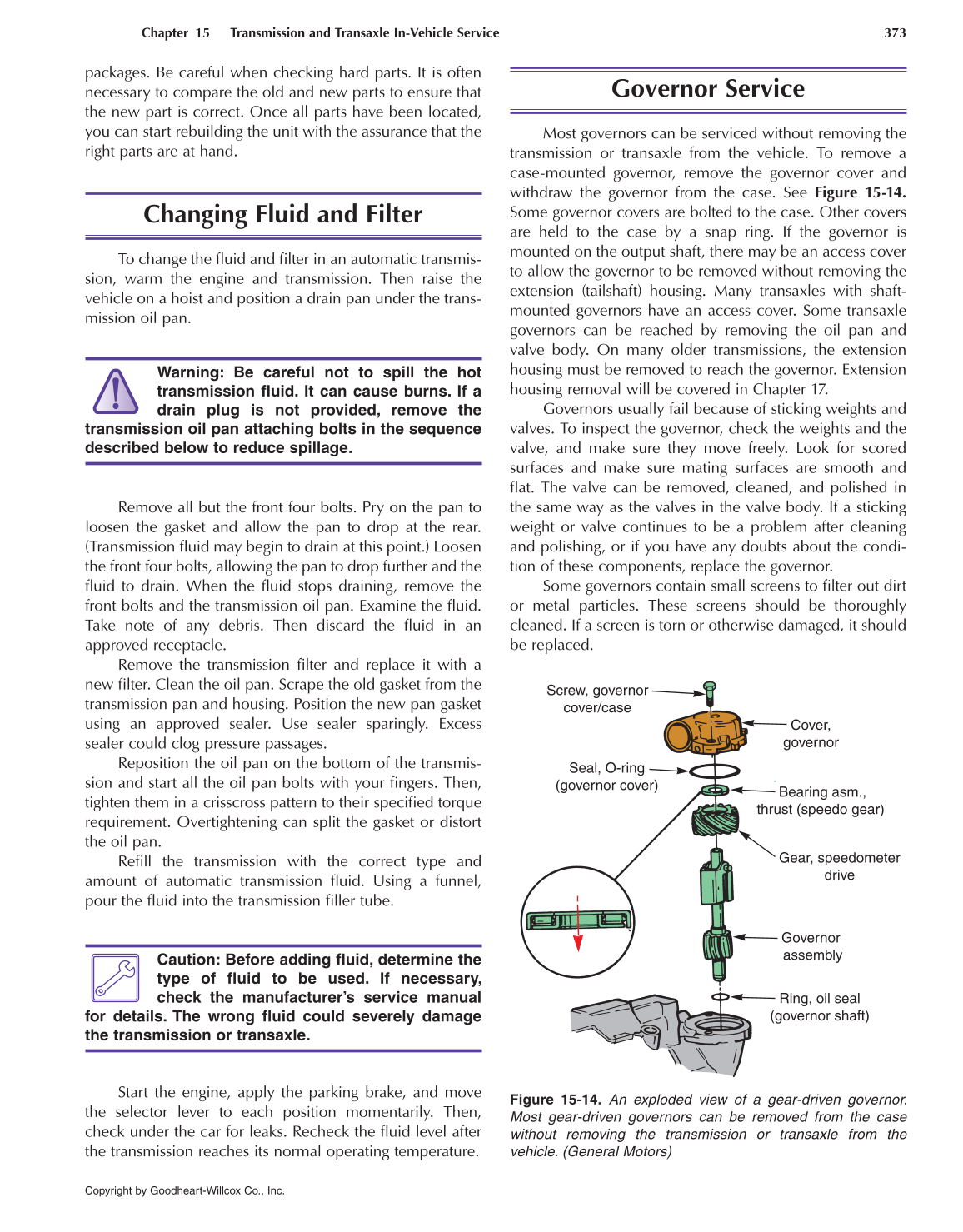Copyright by Goodheart-Willcox Co., Inc.
Chapter 15 Transmission and Transaxle In-Vehicle Service 373
Warning: Be careful not to spill the hot
transmission fluid. It can cause burns. If a
drain plug is not provided, remove the
transmission oil pan attaching bolts in the sequence
described below to reduce spillage.
Caution: Before adding fluid, determine the
type of fluid to be used. If necessary,
check the manufacturer’s service manual
for details. The wrong fluid could severely damage
the transmission or transaxle.
Screw, governor
cover/case
Cover,
governor
Seal, O-ring
(governor cover)
Bearing asm.,
thrust (speedo gear)
Gear, speedometer
drive
Governor
assembly
Ring, oil seal
(governor shaft)
Figure 15-14. An exploded view of a gear-driven governor.
Most gear-driven governors can be removed from the case
without removing the transmission or transaxle from the
vehicle. (General Motors)
packages. Be careful when checking hard parts. It is often
necessary to compare the old and new parts to ensure that
the new part is correct. Once all parts have been located,
you can start rebuilding the unit with the assurance that the
right parts are at hand.
Changing Fluid and Filter
To change the fluid and filter in an automatic transmis-
sion, warm the engine and transmission. Then raise the
vehicle on a hoist and position a drain pan under the trans-
mission oil pan.
Governor Service
Most governors can be serviced without removing the
transmission or transaxle from the vehicle. To remove a
case-mounted governor, remove the governor cover and
withdraw the governor from the case. See Figure 15-14.
Some governor covers are bolted to the case. Other covers
are held to the case by a snap ring. If the governor is
mounted on the output shaft, there may be an access cover
to allow the governor to be removed without removing the
extension (tailshaft) housing. Many transaxles with shaft-
mounted governors have an access cover. Some transaxle
governors can be reached by removing the oil pan and
valve body. On many older transmissions, the extension
housing must be removed to reach the governor. Extension
housing removal will be covered in Chapter 17.
Governors usually fail because of sticking weights and
valves. To inspect the governor, check the weights and the
valve, and make sure they move freely. Look for scored
surfaces and make sure mating surfaces are smooth and
flat. The valve can be removed, cleaned, and polished in
the same way as the valves in the valve body. If a sticking
weight or valve continues to be a problem after cleaning
and polishing, or if you have any doubts about the condi-
tion of these components, replace the governor.
Some governors contain small screens to filter out dirt
or metal particles. These screens should be thoroughly
cleaned. If a screen is torn or otherwise damaged, it should
be replaced.
Remove all but the front four bolts. Pry on the pan to
loosen the gasket and allow the pan to drop at the rear.
(Transmission fluid may begin to drain at this point.) Loosen
the front four bolts, allowing the pan to drop further and the
fluid to drain. When the fluid stops draining, remove the
front bolts and the transmission oil pan. Examine the fluid.
Take note of any debris. Then discard the fluid in an
approved receptacle.
Remove the transmission filter and replace it with a
new filter. Clean the oil pan. Scrape the old gasket from the
transmission pan and housing. Position the new pan gasket
using an approved sealer. Use sealer sparingly. Excess
sealer could clog pressure passages.
Reposition the oil pan on the bottom of the transmis-
sion and start all the oil pan bolts with your fingers. Then,
tighten them in a crisscross pattern to their specified torque
requirement. Overtightening can split the gasket or distort
the oil pan.
Refill the transmission with the correct type and
amount of automatic transmission fluid. Using a funnel,
pour the fluid into the transmission filler tube.
Start the engine, apply the parking brake, and move
the selector lever to each position momentarily. Then,
check under the car for leaks. Recheck the fluid level after
the transmission reaches its normal operating temperature.
